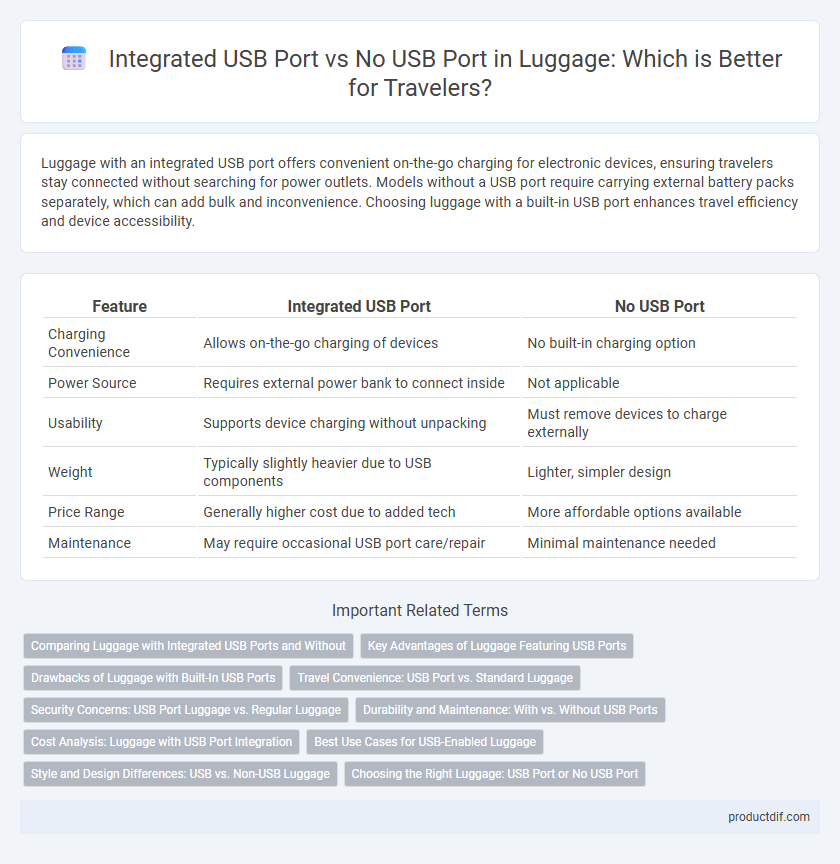Luggage with an integrated USB port offers convenient on-the-go charging for electronic devices, ensuring travelers stay connected without searching for power outlets. Models without a USB port require carrying external battery packs separately, which can add bulk and inconvenience. Choosing luggage with a built-in USB port enhances travel efficiency and device accessibility.
Table of Comparison
| Feature | Integrated USB Port | No USB Port |
|---|---|---|
| Charging Convenience | Allows on-the-go charging of devices | No built-in charging option |
| Power Source | Requires external power bank to connect inside | Not applicable |
| Usability | Supports device charging without unpacking | Must remove devices to charge externally |
| Weight | Typically slightly heavier due to USB components | Lighter, simpler design |
| Price Range | Generally higher cost due to added tech | More affordable options available |
| Maintenance | May require occasional USB port care/repair | Minimal maintenance needed |
Comparing Luggage with Integrated USB Ports and Without
Luggage with integrated USB ports offers the convenience of charging electronic devices on the go by connecting to a power bank inside the suitcase, enhancing travel efficiency and connectivity. In contrast, luggage without USB ports lacks this feature, requiring travelers to rely on external charging options, which can be less practical during transit. Choosing luggage with integrated USB ports caters to tech-savvy travelers who prioritize seamless device management.
Key Advantages of Luggage Featuring USB Ports
Luggage featuring integrated USB ports offers the convenience of charging electronic devices on the go without the need to open the bag, which enhances travel efficiency and security. This feature supports power banks, allowing travelers to maintain connectivity during long flights or layovers, a key advantage over traditional luggage without USB functionality. The seamless charging capability combined with organized compartments makes USB port luggage highly practical for modern tech-savvy travelers.
Drawbacks of Luggage with Built-In USB Ports
Luggage with built-in USB ports often suffers from limited battery capacity and added weight, reducing overall portability and convenience during travel. The external charging feature relies heavily on the traveler remembering to charge the internal battery beforehand, otherwise, the USB port becomes useless. Moreover, these integrated systems can compromise the luggage's durability due to potential water ingress and increased complexity in repairs.
Travel Convenience: USB Port vs. Standard Luggage
Luggage with an integrated USB port significantly enhances travel convenience by allowing travelers to charge devices on the go without unpacking power banks or searching for outlets. This feature streamlines access to smartphones, tablets, and other electronics during travel, reducing downtime and improving connectivity. Standard luggage lacks this functionality, often requiring additional accessories and causing potential delays in device usage.
Security Concerns: USB Port Luggage vs. Regular Luggage
Luggage with an integrated USB port offers convenient device charging on the go but may pose potential security risks such as unauthorized access to devices or data breaches through exposed ports. Regular luggage, without a USB port, minimizes electronic vulnerabilities and reduces the risk of hacking or malware infiltration during travel. Travelers prioritizing cybersecurity should weigh convenience against the possibility of USB port-related security threats when selecting luggage.
Durability and Maintenance: With vs. Without USB Ports
Luggage equipped with integrated USB ports often requires more careful handling and regular maintenance to protect the electronic components from damage, potentially reducing overall durability compared to models without USB ports. In contrast, luggage without USB ports typically offers enhanced structural integrity and simpler upkeep due to the absence of delicate wiring and charging mechanisms. Choosing luggage based on durability and maintenance should weigh the convenience of built-in charging against the increased risk of wear and repair needs.
Cost Analysis: Luggage with USB Port Integration
Luggage with integrated USB ports typically incurs higher manufacturing costs due to the inclusion of electronic components, wiring, and additional design considerations for battery storage and charging safety. This increased production expense often results in a retail price premium compared to traditional luggage without USB ports. Consumers should weigh the convenience of on-the-go device charging against the upfront cost difference when considering USB-integrated luggage options.
Best Use Cases for USB-Enabled Luggage
USB-enabled luggage with an integrated USB port is ideal for frequent travelers and business professionals who need to charge smartphones, tablets, and other devices on the go without unpacking electronics. This feature enables convenient power access at airports, in transit, or during layovers, reducing reliance on airport charging stations and minimizing downtime. For casual travelers or those who prefer minimal accessories, luggage without a USB port offers simplicity and lighter weight, but lacks the charging convenience crucial for tech-dependent trips.
Style and Design Differences: USB vs. Non-USB Luggage
Luggage with integrated USB ports features sleek, modern designs that emphasize convenience and tech-savvy aesthetics, often incorporating discreet external charging pockets and cable management. In contrast, non-USB luggage tends to prioritize traditional styling with cleaner lines and fewer external attachments, appealing to travelers who favor minimalistic or classic looks. The choice between USB and non-USB luggage influences overall design complexity and external appearance, balancing functionality with visual appeal.
Choosing the Right Luggage: USB Port or No USB Port
Choosing luggage with an integrated USB port offers convenient on-the-go charging, ideal for frequent travelers who rely on electronic devices. Luggage without a USB port typically provides increased durability and lighter weight, appealing to those prioritizing simplicity and robustness. Evaluating travel habits and device usage helps determine if the functional advantage of a USB port outweighs potential compromises in luggage design.
Integrated USB Port vs No USB Port Infographic

 productdif.com
productdif.com